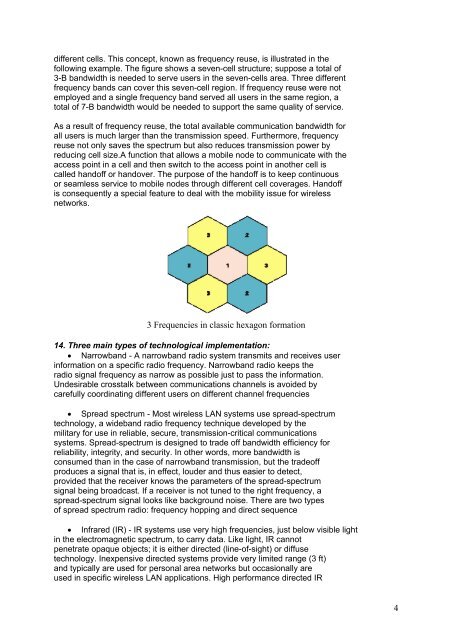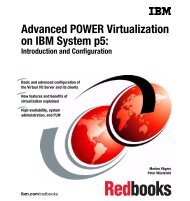Wireless LAN
Wireless LAN
Wireless LAN
You also want an ePaper? Increase the reach of your titles
YUMPU automatically turns print PDFs into web optimized ePapers that Google loves.
different cells. This concept, known as frequency reuse, is illustrated in the<br />
following example. The figure shows a seven-cell structure; suppose a total of<br />
3-B bandwidth is needed to serve users in the seven-cells area. Three different<br />
frequency bands can cover this seven-cell region. If frequency reuse were not<br />
employed and a single frequency band served all users in the same region, a<br />
total of 7-B bandwidth would be needed to support the same quality of service.<br />
As a result of frequency reuse, the total available communication bandwidth for<br />
all users is much larger than the transmission speed. Furthermore, frequency<br />
reuse not only saves the spectrum but also reduces transmission power by<br />
reducing cell size.A function that allows a mobile node to communicate with the<br />
access point in a cell and then switch to the access point in another cell is<br />
called handoff or handover. The purpose of the handoff is to keep continuous<br />
or seamless service to mobile nodes through different cell coverages. Handoff<br />
is consequently a special feature to deal with the mobility issue for wireless<br />
networks.<br />
3 Frequencies in classic hexagon formation<br />
14. Three main types of technological implementation:<br />
• Narrowband - A narrowband radio system transmits and receives user<br />
information on a specific radio frequency. Narrowband radio keeps the<br />
radio signal frequency as narrow as possible just to pass the information.<br />
Undesirable crosstalk between communications channels is avoided by<br />
carefully coordinating different users on different channel frequencies<br />
• Spread spectrum - Most wireless <strong>LAN</strong> systems use spread-spectrum<br />
technology, a wideband radio frequency technique developed by the<br />
military for use in reliable, secure, transmission-critical communications<br />
systems. Spread-spectrum is designed to trade off bandwidth efficiency for<br />
reliability, integrity, and security. In other words, more bandwidth is<br />
consumed than in the case of narrowband transmission, but the tradeoff<br />
produces a signal that is, in effect, louder and thus easier to detect,<br />
provided that the receiver knows the parameters of the spread-spectrum<br />
signal being broadcast. If a receiver is not tuned to the right frequency, a<br />
spread-spectrum signal looks like background noise. There are two types<br />
of spread spectrum radio: frequency hopping and direct sequence<br />
• Infrared (IR) - IR systems use very high frequencies, just below visible light<br />
in the electromagnetic spectrum, to carry data. Like light, IR cannot<br />
penetrate opaque objects; it is either directed (line-of-sight) or diffuse<br />
technology. Inexpensive directed systems provide very limited range (3 ft)<br />
and typically are used for personal area networks but occasionally are<br />
used in specific wireless <strong>LAN</strong> applications. High performance directed IR<br />
4
















